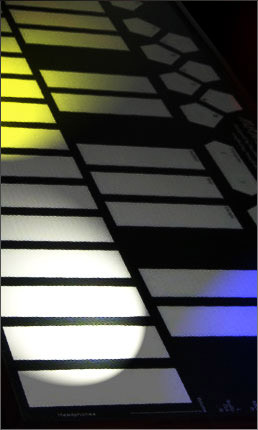


Modeled somewhat after its acoustic namesake, Marimba Lumina is an electronic MIDI controller that brings an extended vocabulary and range of expression to the mallet instrument family.

The Marimba Lumina is a mallet controller designed by Don Buchla and made by Joel Davel. It has a traditional bar arrangement like a marimba or a vibraphone, but with RF technology that recognizes each mallet independently and the mallet's position along the length of the bar, it has expressive possiblilties beyond a typical keyboard.
Marimba Lumina's flat playing surface also includes hex "pads" and "strips" (reminiscent of those early ribbon controllers), and an 80-character display. The instrument is played with unique foam covered mallets. Although primarily a controller able to connect to the latest hardware and software synthesizers through the MIDI protocol, Marimba Lumina also has a built in synthesizer, and can thus function as a complete instrument..
Marimba Lumina adds a few tricks to the usual capabilities of a keyboard mallet instrument. Augmenting the potential for expressive control, Marimba Lumina responds to several new performance variables, including position along the length of the bars, mallet prescence, dampening, and note density. User definable "Zones" also allow portions of the instrument to respond to gesture in different ways.
And on top of that, Marimba Lumina can identify which of four color-coded mallets has struck. This allows one to program different sounds or instrumental responses for each mallet, to implement musical structures in which one mallet selects a course of action while others modify or implement it, or to simplify voice leading and give each mallet independent expressive control it's assigned sound.
Marimba Lumina contains a particularly friendly user interface, and a mallet activated editing facility. Advanced software allows complex relationships between performance gestures and musical responses to be readily defined. Virtual pitch wheels, pan pots, level sliders and modulation wheels are easily implemented. User definable keymaps and tuning tables provide for alternate tunings and ancillary drumkits. Abundant permanent programs are provided or can be spiced up a bit to suit individual tastes. Memory cards facilitate storage, backup, and exchange of programs.
Living up to its namesake, the Marimba Lumina has LED illumination built into every bar, strip, and pad. These LED's can show key status, edit configuration, controller status or pad selection. Key status usually means it shows when a MIDI note is being sustained with it's programmed duration or by the sustain pedal. Using the LEDs pedagogically, they can help a player follow a MIDI sequence or the actions of another player. Or the LEDs can simply all be turned on.
The Marimba Lumina was designed by synthesizer pioneer Don Buchla with a lot of help from percussionist / programmer Mark Goldstein and marimbist / sound designer Joel Davel. When Absolute Deviation started, the first change Joel Davel implemented was a CPU upgrade to speed up it's operation.







